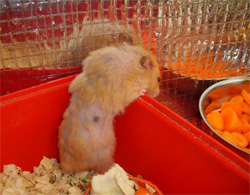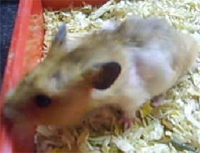| |
Fur loss in Hamster
Fur or hair loss in a hamster can occur for a number of reasons, it can be due to both disease and non-disease conditions, and is a fairly common problem especially in hamsters over a year + old. Continual rubbing on feeders or sides of the cage may be one cause but the most common reason for hair loss is age related. Age related fur loss is generally first seen starting around the tummy area then onto the hind legs and hips then neck and chest.

An ageing male hamster with fur loss.The black spot that can been on his side is the hamsters hip spot, known as the sebaceous glands
|
Protein and vitamin deficiency can be another cause. A high diet of seed, particularly sunflower seed can lead to obesity and potential nutritional deficiencies. Vitamin deficiencies can easily be rectified by providing a high quality and a good balanced diet and supplementing the diet with water soluble vitamins from the pet store that may help in restoring any lost vitamins. I don't normally agree with these products but there may be something lacking, and it would probably do no harm trying them as any excess of water soluble vitamins are simply flushed out in the urine. Other supplements to the diet may include breakfast cereals (unsweetened) whole wheat pasta, cheese, boiled eggs, yogurt, and fresh vegetables.
It is the deficiency of the B vitamins, especially B6 biotin, inositol and folic acid in the diet that can lead to fur loss and tiredness amongst a host of other things. All of these B vitamins are essential for the normal formation of red blood cells or the haemoglobin (iron-containing) portion of red blood cells. Most of the above listed food contains these vitamins.
A deficiency in most B vitamins can lead to tiredness, weakness, and fur loss
Vitamin B-1: leads to weakness and fatigue.
B-6: hair / fur loss and muscular weakness.
Inositol: Is also a member of the B group, this is vital for fur growth. In laboratory trails recently animals that lacked Inositol in the diet produced fur loss (baldness) but when the vitamin was again added to the food of these animals the fur grew back.
Inositol: May be found in bananas, brown rice, oat flakes, vegetables, wheat germ, nuts, If the inositol intake is not sufficient symptoms such as fur loss and skin problems can arise.
Hair / fur loss can occasionally be caused by lack of protein in the diet. Diets that exclude, or has an insufficient protein intake may develop protein malnutrition. When this happens the body will help to save what little protein there is by shifting growing hairs into the resting phase (inter-phase) Dietary sources of protein include eggs, nuts, grains, legumes, and dairy products such as cheese, yogurt, tofu etc:
Fur loss may also be seasonal as hamsters moult during the summer and autumn and is at this time they may have periods where their fur / coats may become patchy and have areas of fur loss. Fur loss can happen also during times of sudden and extreme temperature changes. A hamster may shed fur if conditions become too hot for prolonged periods of time. Fur loss due to moulting is nothing to be concerned about as most furred animals shed their fur once or twice a year, during this period areas of thick and thin patches of fur may be seen. All species of hamsters moult, but the Chinese and Roborovski hamster are generally less affected than the Russian or the Syrian hamster.
As hamsters age some may begin to lose fur. The underlying skin that becomes exposed may become dry and scaly. This is particularly more so with the male hamster, the dryness may be so severe that the skin becomes thickened and scaly with a white hard eggshell like appearance over the hamsters back. This is a condition caused by the reduced production of the natural moisturizer called (sebum) and a problem seen only with advancing age.
It results from lack of water in the top layer of skin. With increasing age the skin holds less and less water. Sebum is acidic oil, it forms an acidic layer over the skin; this layer is called the acid mantle, and stops all the bacteria that want to invade the skin. It also protects the top layer of skin which is made of dead cells and keeps the moisture inside. The main purpose of sebum is to make the skin and hair waterproof and to protect them from drying out keeping them from becoming dry and cracked. Sebum production naturally decreases with age and males are more susceptible to this condition than the female are, the reason for this is the secretion of sebum is stimulated by hormones (androgens) and testosterone levels decline in the male hamster as he ages, therefore so does the secretion of sebum. The folds in the skin then starts to crack, bacteria then enters the cracks and wounds leading to the more serious condition of dermatitis.
Other ailments and conditions that may cause fur loss Mites Ringworm Allergies Fleas

A very old female hamster that has lost almost all of her fur at 2 years 8 month old |
In the video below: An ageing female hamster with age related fur loss.
A Hamster with age related fur loss. 
In this video below this young male hamster is in a summer moulting. As you can see the fur is patchy over the entire body. Once the moult is complete and excess fur is shed the coat will be back to normal again.
A hamster in moult 
A young hamster with fur loss maybe in moult:

A young male Hamster in Moult |
|
|


